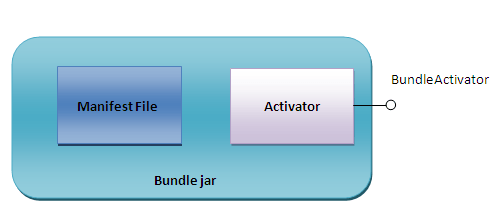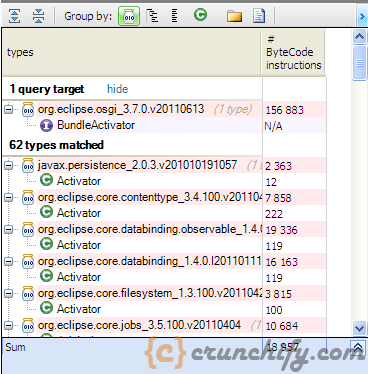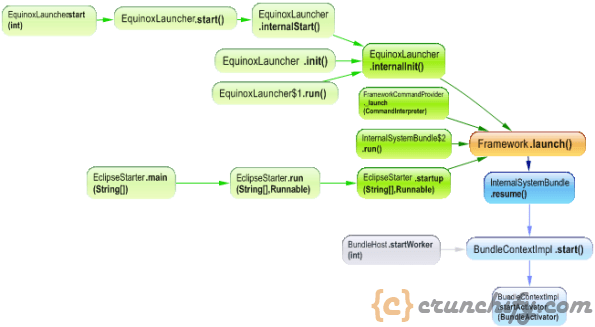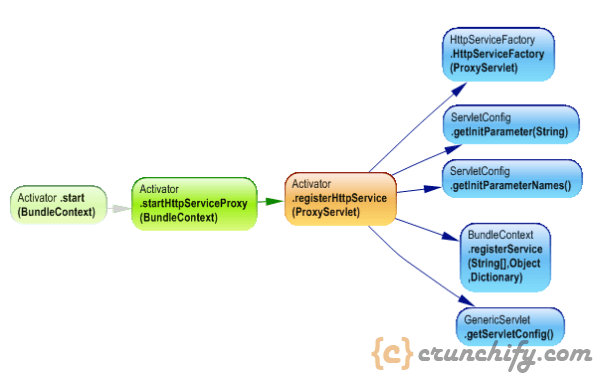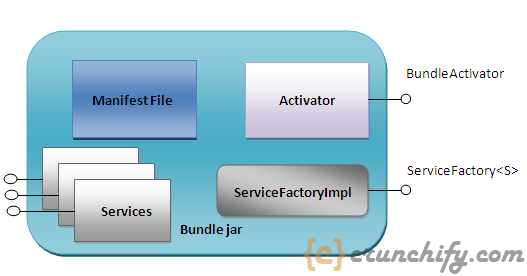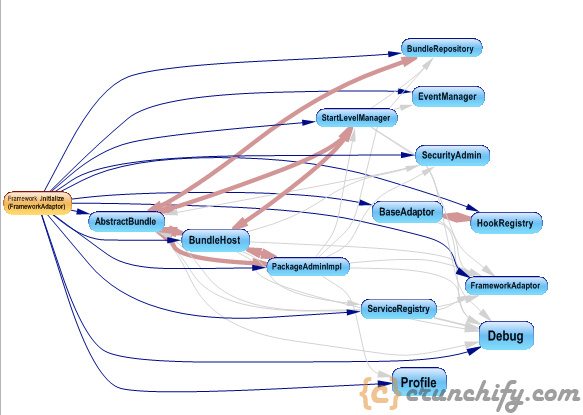OSGi became very popular today, thanks to its modularity approach and its capability to enforce logical boundaries between modules. When we discover it the first time, the question is where to begin to understand how it works?
To understand OSGi concepts we will try to follow the puzzle approach, the idea is to begin with the trivial part of this technology, and search for other parts related to the found ones. And to assemble the puzzle we will be assisted by JArchitect that will be helpful to detect OSGi internal design.
To be more concrete we analyze with JArchitect an application using OSGi technology, it concern the famous eclipse IDE which use the OSGi container equinox.
Let’s begin with the typical OSGi definition:
OSGi reduces complexity by providing a modular architecture for today’s large-scale distributed systems as well as small, embedded applications. Building systems from in-house and off-the-shelf modules significantly reduces complexity and thus development and maintenance expenses. The OSGi programming model realizes the promise of component-based systems.
The trivial part of OSGi is modularity, let’s discover what’s the OSGi modules?
OSGI modules are called Bundles and every application therefore consist of at least one bundle.
These bundles are executed inside a container, and as each modular approach where a container manage the modules, the question is which contract must implement every module to be integrated into the container?
Let’s take as example the bundle org.eclipse.equinox.jsp.jasper and search for all its implemented interfaces, for that we can execute the following CQLinq request:
from t in Types where t.ParentProject.Name==”org.eclipse.equinox.jsp.jasper_1.0.300.v20110502“ let interfaces=t.InterfacesImplemented from i in interfaces select i
The BundleActivator interface from OSGi package is implemented, this interface contains two methods start and stop useful to customize the starting and stopping of the bundle.
Another specificity of a bundle is its manifest file, here’s a part from the org.eclipse.equinox.jsp.jasper manifest file:
Manifest-Version: 1.0 Bundle-Localization: plugin Bundle-RequiredExecutionEnvironment: CDC-1.0/Foundation-1.0,J2SE-1.3 Bundle-SymbolicName: org.eclipse.equinox.jsp.jasper Eclipse-LazyStart: true Eclipse-SourceReferences: scm:cvs:pserver:dev.eclipse.org:/cvsroot/rt: org.eclipse.equinox/server-side/bundles/org.eclipse.equinox.jsp.jaspe r;tag=v20110502 Bundle-Activator: org.eclipse.equinox.internal.jsp.jasper.Activator
As we can observe this manifest contains some meta informations needed by the container, like specifying the bundle activator class which implements the BundleActivator interface.
The bundle represents our first piece of the puzzle, and here’s a simplified representation of a bundle:
And just to have an idea of all bundles used by eclipse, let’s search for all classes implementing BundleActivator interface.
from t in Types where t.Implement (“org.osgi.framework.BundleActivator“)
select new { t, t.NbBCInstructions }
Who manage the bundle and invoke BundleActivator methods?
To discover that let’s search for methods invoking directly or indirectly BundleActivator.start
from m in Methods
let depth0 = m.DepthOfIsUsing(“org.eclipse.osgi.framework.internal.core.BundleContextImpl.startActivator(BundleActivator)“)
where depth0 >= 0 orderby depth0
select new { m, depth0 }
The bundle is activated by the OSGi framework when it’s launched. The framework class is started by the equinox container. And to understand better what happen when the container starts, here are some actions executed when the container is launched:
When the container is launched, it initialize the OSGi framework, the framework gets all installed bundles, and for each one it create an instance of BundleHost class, and store into a repository the found bundle.
The BundleHost class implement the Bundle interface, which contains methods like start,stop,uninstall and update, these methods are needed to manage the bundle life cycle.
So our second puzzle piece is The OSGi container, it’s launched by the Equinoxlauncher, which initialize the framework. The framework class is responsible of loading bundles and activates them.
After discovering some basic concepts about bundle and container, let’s go deep inside bundles and discover how they work internally.
Let’s take as example the org.eclipse.equinox.http.servlet bundle and search for methods invoked by the start method of its Activator class.
This bundle creates a service and registers it into the container. A service in OSGi is defined by a standard Java class or interface. Typically a Java interface is used to define the service interface. The service is the preferred method bundles should use to communicate between each other.
Here are some useful scenarios of using services:
- Export functionality from a bundle to other bundles.
- Import functionality from other bundles.
- Register listeners for events from other bundles.
Another remark from the previous dependency graph is that a service factory is used to create the service instance.
Our third piece of the puzzle is the OSGi services layer, each bundle can use or declare some services, what enforce the component design approach, here’s the new representation of the OSGi bundle.
If The bundle use services to communicate with other bundles, how it communicate with other jars?
If we develop a bundle and try to use a class from another jar, we can be surprised that it will not works as expected, the reason is that the ClassLoader is hooked by the OSGi container, to check that let’s search which method invoke java.lang.Thread.setContextClassLoader.
from m in Methods where m.IsUsing (“java.lang.Thread.setContextClassLoader(ClassLoader)“)
select new { m, m.NbBCInstructions }
Many methods invoke it including the EquinoxLauncher. so every time the bundle try to create a class instance, the OSGi container will check if the code is permitted to did this action or not, and here come the role of imported and exported package in the manifest file.
Export-Package: org.eclipse.equinox.http.servlet;version=”1.1.0″ Import-Package: javax.servlet;version=”2.3″,javax.servlet.http;version =”2.3″,org.osgi.framework;version=”1.3.0″,org.osgi.service.http;versi on=”[1.2,1.3)”
The bundle declare explicitly exported and imported package, and to check that , let’s search for packages used by org.eclipse.equinox.http.servlet bundle and verify if it use only package imported.
from n in Packages where n.IsUsedBy (“org.eclipse.equinox.http.servlet_1.1.200.v20110502“)
select new { n, n.NbBCInstructions }
As we can observe all packages used are specified in the manifest file, in the import package section.
The exported package however represents the package that can be used from other bundles. it’s represented by the ExportedPackage interface, and we can search for the container classes using this interface.
from t in Types where t.IsUsing (“org.osgi.service.packageadmin.ExportedPackage“)
select new { t, t.NbBCInstructions }
What interesting with this new capability, is that the bundle will have a well defined boundary, and what it use and what it expose as services is very well specified.
We can enforce the check of using imported packages by using other tools, for example with CQLinq we can write some rules warning each time a project use packages other than specified ones, but it’s better to have this check in the execution environment, so the developer can’t break these rules.
This capability to treat imported and exported packages is managed by the OSGi modules layer and it was our fourth piece of the puzzle.
Let’s come back to the OSGi container and discover which services it provides?
Container services
As we discovered before the container is launched by the EquinoxLauncher class and the framework class initialize and launch the bundles, to detect which services are provided let’s search for all classes used in the framework initialization method.
from t in Types where t.IsUsedBy (“org.eclipse.osgi.framework.internal.core.Framework.initialize(FrameworkAdaptor)“)
select new { t, t.NbBCInstructions }
Some classes are already discovered before like BundleRepository,BundleHost,PackageAdminImpl and ServiceRegistry.
What about the other classes:
- StartLevelManager:
Each OSGi Bundle is associated with a start level that enable the server to control the relative starting and stopping order of bundles. Only bundles that have a start level less or equal to the active start level of the server framework must be active. Usually, a bundle with a smaller start level tends to be started earlier. - SecurityAdmin:
The security layer handles the security aspects by limiting bundle functionality to pre-defined capabilities. - EventManager:
The Event Admin service provides a publish-subscribe model for handling events. It is realized according to the OSGi Event Admin Service Specification.The Event Admin service dispatches events between Event Publishers and Event Subscribers (Event Handlers) by interposing an event channel. Publishers post events to the channel and the event channel defines which handlers needs to be notified. Thus publishers and handlers have no direct knowledge of each other, which simplifies event management.
The OSGi whole picture
Let’s assemble all puzzle pieces described before , and we will have the following OSGi picture:
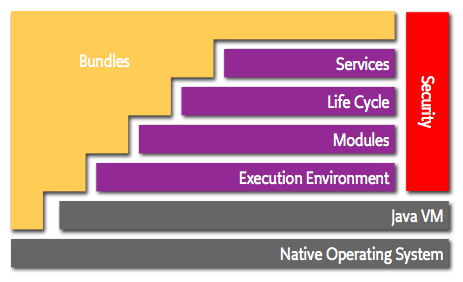
This architecture has the following interesting benefits:
- Simple.
- Reduced Complexity.
- Easy Deployment.
- Secure.
What makes it very attractive and Worth a Detour, and you will not waste your time if you study it in depth.


